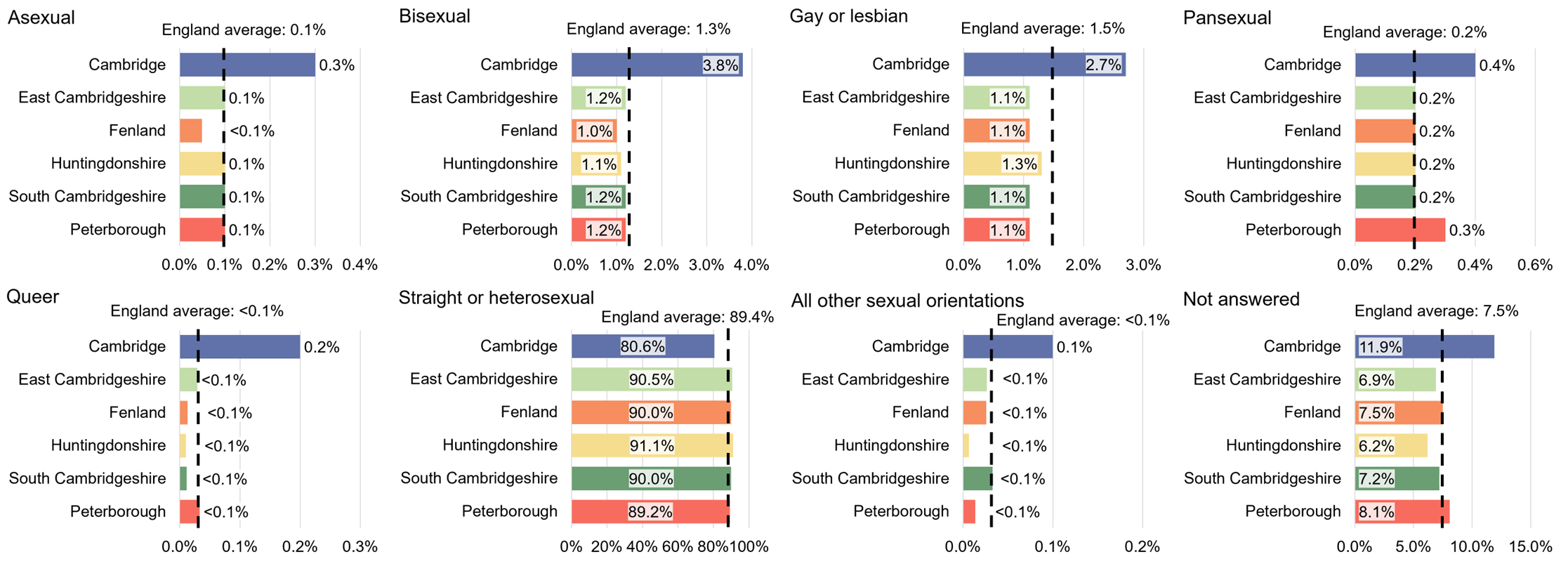Sexuality
- LGBQ+ adults and teenagers are at a higher risk of a range of mental health conditions than their heterosexual peers, and have a:
-
- 5 times higher risk of depression and anxiety (Amos et al., 2020; Semlyen et al., 2016).
- An increased risk of having multiple mental health conditions (Amos et al., 2020).
- An increased risk of self-harm (Martin. Mitchell et al., 2009).
- 3 times higher risk of suicidal ideation (Woodhead et al., 2016).
- 2 times higher risk of suicide attempts (Hudson-Sharp & Metcalf, 2016).
-
- LGBQ+ people are also at a higher risk of substance use (Woodhead et al., 2016), poor wellbeing (Amos et al., 2020; Semlyen et al., 2016) and low self-esteem (Amos et al., 2020).
- Compared to lesbian women, bisexual women are (Bignall et al., 2019):
- 37% more likely to self-harm.
- 64% more likely to have an eating disorder.
- 26% more likely to have felt depressed or sad in the past year.
Local population
The proportion of people who identify as LGBQ+ (lesbian, gay. bisexual or other sexual orientations) varies across Cambridgeshire and Peterborough (Office for National Statistics, 2022d). The highest proportion is in Cambridge, where 2.7% of people are lesbian or gay, 3.8% are bisexual and 0.9% have another sexual orientation (most commonly pansexual, asexual or queer).

Figure 23: Sexual orientation in Cambridgeshire and Peterborough in 2021. Data source: (Office for National Statistics, 2022d)
Risk factors for poor mental health
People who are LGBQ+ are more likely than heterosexual people to experience risk factors for poor mental health, including:
- Familial rejection (Hudson-Sharp & Metcalf, 2016).
- Being bullied in school (Amos et al., 2020), which is associated with an increased risk of suicide and self-harm (Hudson-Sharp & Metcalf, 2016). One large scale survey found that almost half of LGBTQ+ young people’s time in school was impacted by discrimination or fear of discrimination (Children and Young People’s Mental Health Coalition & Centre for Mental Health, 2022).
- Homelessness (Martin. Mitchell et al., 2009): 24% of young people experiencing homelessness are LGBT, over 3 in 4 of whom believe ‘coming out’ to their parents was the main driver of them becoming homeless (Albert Kennedy Trust, 2015).
- Homophobia, biphobia and other forms of prejudice and discrimination related to their sexual orientation (Hudson-Sharp & Metcalf, 2016). The fear of being subjected to a hate crime can also cause anxiety and stress (Hudson-Sharp & Metcalf, 2016).
- LGBQ+ people from ethnic minority groups are more likely to experience homophobic or biphobic violence, abuse and harassment (Martin. Mitchell et al., 2009).
- 1 in 4 LGBQ+ adults have a disability, and face specific challenges such as (Movement Advancement Project, 2019):
- Higher rates of harassment and employment discrimination.
- Limited accessible LGBQ+ inclusive services and spaces.
Access
Research by the local organisation The Kite Trust highlights that young LGBTQ+ people in Cambridgeshire and Peterborough face multiple barriers to accessing mental health services, including that some professionals lack understanding of LGBTQ+ identities and experiences (Turney & Gardner, 2022). This report concluded that mental health need is not always met by services, particularly for neurodivergent young people and those with multiple mental health conditions.
Experience
- Nationally, 7% of LGB+ people report having experienced difficulty accessing healthcare because of their sexuality (Bachmann & Gooch, 2018).
- National evidence from 2016 highlights that LGBQ+ people have higher rates of dissatisfaction across health services, which mostly results from experiences of discrimination, heteronormativity, and a lack of staff information and knowledge of LGBQ+ people’s health needs (Hudson-Sharp & Metcalf, 2016).
- A large-scale national survey found that 1 in 8 LGBT people have experienced unequal treatment from healthcare staff because of their sexuality and/or gender identity: this was higher in lesbians (17%), compared to bisexual men (11%) and women (8%), and gay men (9%) (Bachmann & Gooch, 2018).
- 43% of older LGBT+ people (over 55) are not confident that mental health services will understand and meet their needs, much higher than the rate (33%) in their heterosexual peers (Hudson-Sharp & Metcalf, 2016).
Outcomes
LGBQ+ people are more likely to report having ‘lasting negative effects’ from psychological treatment for anxiety or depression than heterosexual people, with bisexual people facing almost twice the risk (M. J. Crawford et al., 2016).
In Cambridgeshire and Peterborough, bisexual people have consistently worse outcomes from Talking Therapies and have a 11% lower rate of recovering from mental health problems than heterosexual or gay/lesbian people (NHS Digital, 2021). This group is also the most likely to experience a deterioration in mental health after completing treatment.

Table 10: The proportion of people who have consistent recovery, improvement and deterioration in their mental health for referrals for NHS Talking Therapies (previously known as IAPT) who finished treatment in 2020/21 by sexuality, across Cambridgeshire, Peterborough and England. The * indicates a count based on less than 5 individuals, which has been suppressed to protect patient confidentiality. Data source: (NHS Digital, 2021)
Additional resources
- The local data pack gives an overview of key data and trends
- Stonewall’s report LBGT in Britain
- Cambridgeshire and Peterborough LGBTQ+ Needs Assessment 2022
- The Kite Trust’s report LGBTQ+ Youth Mental Health in Cambridgeshire and Peterborough
- National Institute of Health Research’s summary of the importance of sexual orientation to public mental health
References
Full list of references is included at the end of this chapter.
